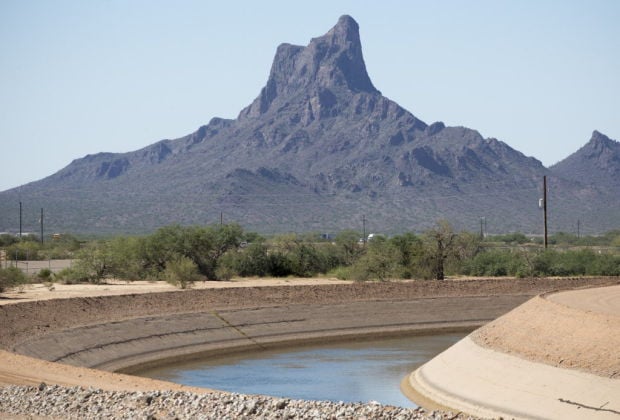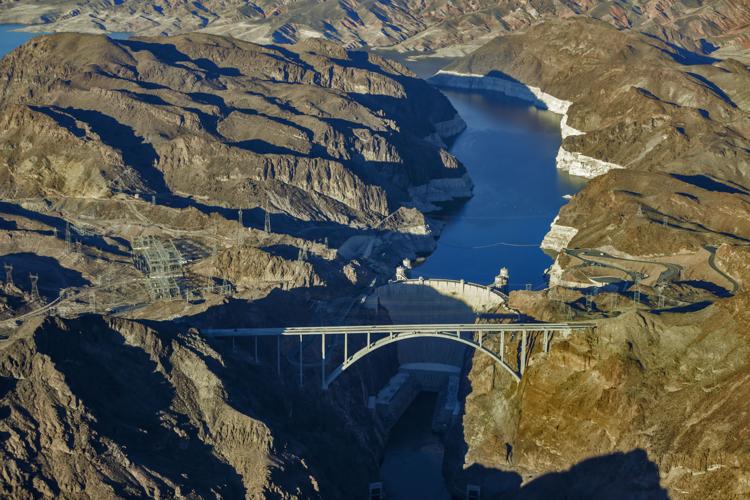Phoenix and Tucson have reached another water-sharing agreement: to store a substantial amount of Phoenix’s Colorado River supply in the Tucson area next year even as Tucson leaves a substantial portion of its supply in ailing Lake Mead.
Tucson will leave nearly 20 percent of its Central Arizona Project water supply in Mead next year, in hopes of propping up the declining lake and pushing back the date of shortages that would cut deliveries, particularly to cities.
Tucson and Phoenix also have agreed to have Phoenix store much more of its CAP supply in a Tucson-area underground aquifer next year than planned. The upshot of the deal is that even though Tucson will leave a lot of water in Lake Mead, it will still put even more CAP into its Avra Valley recharge basins next year than it normally does.
But when a future Colorado River shortage occurs, Phoenix would get to make use of the same amount of Tucson’s share of CAP water as it’s now getting ready to store in Tucson. It’s a trade-off that pleases water leaders in both cities, as well as Arizona’s top water official.
“The actions like that which are taken by water users to conserve water in Lake Mead is a very positive thing,” said Arizona Department of Water Resources Director Tom Buschatzke. “I haven’t heard from anyone else interested in doing what Tucson is doing, but maybe when they hear Tucson is doing that, other folks will step forward.”
Tucson’s mayor and City Council strongly support Tucson Water’s action, but several members are frustrated that the utility acted unilaterally. Tucson Water Director Timothy Thomure said that was because City Manager Michael Ortega had to place a CAP order for next year by Oct. 3, and the negotiations with water project officials and others involved in this deal weren’t wrapped up until Sept. 29. For various reasons, the issue wasn’t brought to the council until this week.
Mayor Jonathan Rothschid and council members Steve Kozachik, Paul Cunningham and Karin Uhlich said this isn’t acceptable and that they want to be involved earlier in such negotiations in the future.
“This is about our future,” Cunningham said. “Without water there is no Tucson left.”
While it’s constructive for Tucson to collaborate with cities such as Phoenix, “that does not mean the decisions should start getting made by a handful of staff members,” Uhlich said. “Water is worth more than gold here. It’s life.”
Specifically, the Tucson-Phoenix arrangement works like this:
- Next year, Tucson will leave 26,000 feet of its 144,000 acre-foot CAP supply in Lake Mead. Typically, Tucson Water takes all the water, but stores nearly one-third in Avra Valley recharge basins for when it’s needed in times of shortage. It usually puts the rest of that water into the same basins and pumps it out over the course of a year.
- Phoenix will store 36,500 acre-feet in the Avra Valley basins next year, and put an additional 3,500 acre-feet in another recharge basin for Metro Water’s future use. Typically, Phoenix uses about two-thirds of its total CAP supply, and the rest goes to other, Arizona-based CAP users such as farmers and the Arizona Water Bank. The bank stores it in its recharge basins for future use.
- When a Colorado River shortage occurs that’s severe enough to affect cities, Tucson could pump the Phoenix-stored water for its use. Phoenix, in turn, could pull a similar amount of Tucson’s CAP supply in the same year as the water heads down the project’s concrete canal to one of two Phoenix-area CAP treatment plants.
- This arrangement saves Tucson $5.3 million next year. That’s $1.8 million in payments from Phoenix for storing its water down here, and the $3.5 million it saves in payments to CAP for unordered water.
While this arrangement is now only for next year, Phoenix Water Director Katherine Sorensen said she hopes it will become a long-term arrangement. Thomure said it’s possible that Tucson Water will come to the council about extending this setup for three to five years.
This is the second time the two cities have agreed to increase the scope of their water-sharing agreement since they first signed it in 2014.
This agreement comes as water officials around the Southwest are negotiating a three-state agreement to reduce their use of Colorado River water in hopes of reducing if not arresting Lake Mead’s continued decline. The lake is expected to end 2017 barely 3 feet above 1,075 feet. Below that level, an initial shortage would be declared, slashing water deliveries to Arizona farmers and the water bank.
The bigger concern is that if additional steps aren’t taken to keep more water in Mead, in 10 percent of all possible future scenarios Mead would drop to 1,025 feet by 2019, according to computer models. At that level, Arizona cities would face CAP shortages, Thomure said. But with the water use cuts now being considered by the three states, plus Tucson’s reduction, the odds of the lake hitting 1,025 feet would be reduced to less than 10 percent in most years through 2026, he said.
Now, with five years worth of CAP water stored underground in the utility’s basins and others run by the water bank, “we are rich with water,” Thomure said.
“We can build a fence around Tucson and say that we’re resilient and we don’t need to participate in discussions with other cities, but we’re at risk if we do so,” he said. “We’re better off if we work collectively, in a much better position for the long term.”
It’s in Phoenix’s best interest to store as much CAP in Tucson-area aquifers as it can, water director Sorensen added. Currently, Phoenix’s ability to store its CAP water in underground aquifers in its area is limited because it abandoned most wellfields back in the 1980s when it switched to CAP, Sorensen said.
Phoenix can meet only 5 percent of its total demand with groundwater, “which is very concerning to us,” she said.





